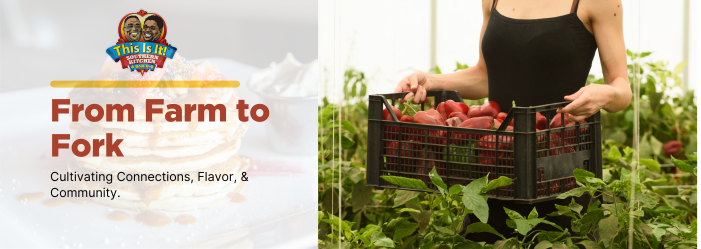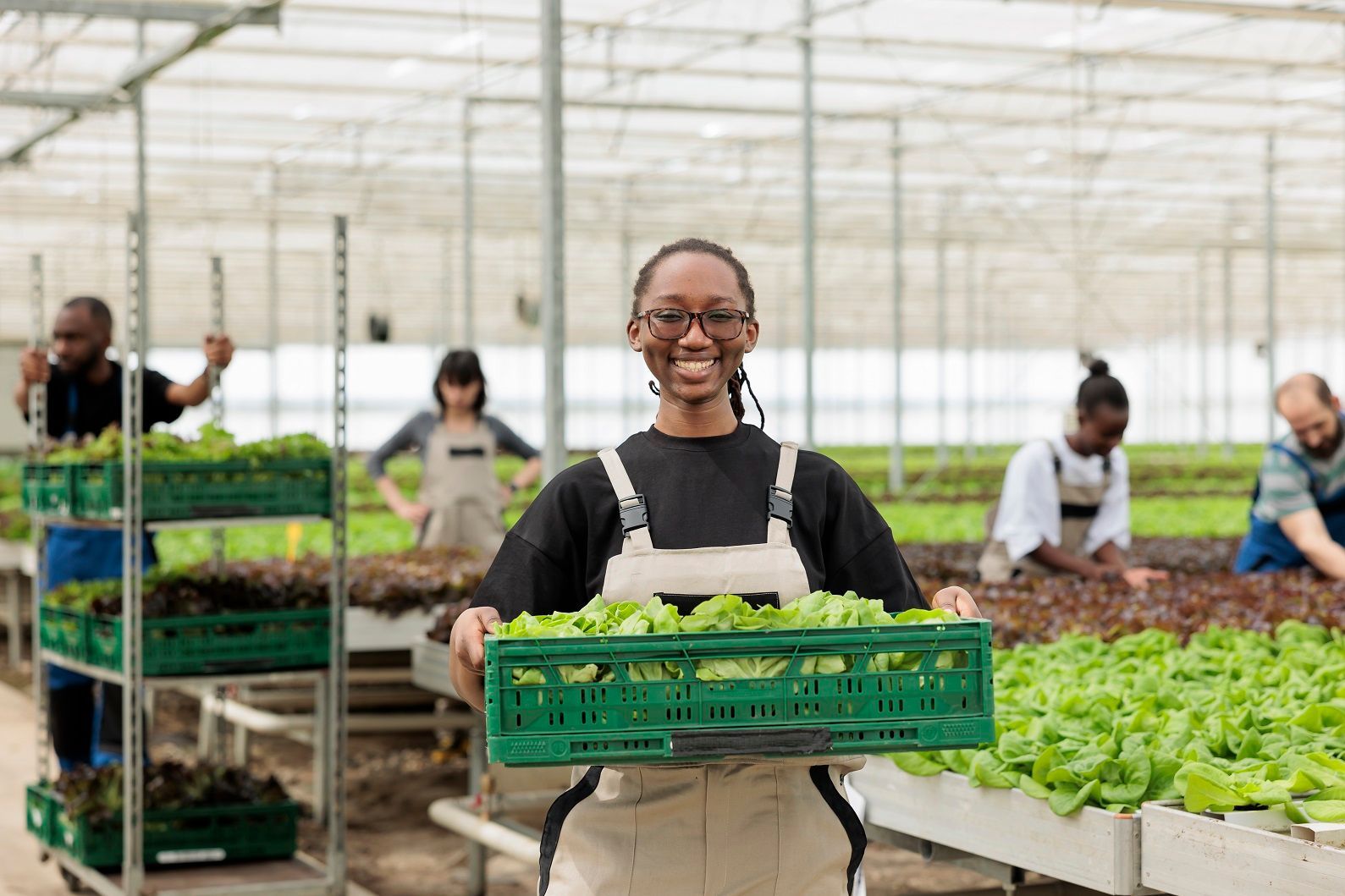From Farm to Fork: Cultivating Connections, Flavor, and Community
Cultivation Connections, Flavor and Community

In today's fast-paced world, our food often travels thousands of miles before reaching our plates. This disconnect between consumers and the source of their nourishment has significant implications for taste, quality, environmental impact, and community well-being.
Here are Some Aspects to Look out for
- The Allure of Local: A Symphony of Flavor and Freshness
- Beyond the Plate: The Environmental Benefits of Local Food
- Building Bridges: Partnering with Local Farmers
- The Power of Storytelling: Showcasing the Hands Behind the Harvest
- Fostering Community Engagement:
From Farm Dinners to Educational Initiatives
- Navigating the Challenges: Overcoming Hurdles in the Local Food Movement
- Overcoming Obstacles: Creative Solutions for Local Food Systems
- A Shared Harvest: The Future of Food Systems
- Beyond the Basics: Deep Dives into Specific Aspects of Local Food
- Exploring the Economic Impact of Local Food Systems
- Local Food and Food Security
- The Role of Seasonality in Local Food
- Benefits of Seasonal Eating
- Tips for Embracing Seasonality
- Exploring Local Food Policy
- The Rise of Culinary Tourism and Agritourism
- Conclusion
However, a growing movement is reclaiming the power of local food systems, fostering a "farm-to-fork" approach that celebrates fresh, seasonal produce, builds partnerships with local farmers, and strengthens the fabric of our communities.
The Allure of Local: A Symphony of Flavor and Freshness
There's something undeniably special about biting into a fruit or vegetable bursting with flavor, its freshness a testament to its journey – not across continents, but from a nearby farm. Locally sourced produce ripens naturally, untouched by chemical preservatives or long-distance transportation. This results in a symphony of taste, with each bite capturing the essence of the land and the care of the farmer who nurtured it.
Beyond the Plate: The Environmental Benefits of Local Food
The environmental advantages of local food systems are numerous. By eliminating the need for long-distance transportation, we reduce our carbon footprint significantly. Locally grown food requires less packaging and refrigeration, further minimizing environmental impact. Additionally, local farms often employ sustainable practices that promote soil health, biodiversity, and water conservation. Supporting these practices ensures a healthier planet for generations to come.
Building Bridges: Partnering with Local Farmers
A key pillar of the farm-to-fork movement is the creation of strong partnerships between consumers and local farmers. By forging these connections, we ensure the viability of local farms, many of which are small and family-owned. These partnerships allow farmers to receive fair compensation for their hard work, while consumers gain access to high-quality food with a transparent origin story.
The Power of Storytelling: Showcasing the Hands Behind the Harvest
One of the most captivating aspects of the farm-to-fork movement is the opportunity to connect with the individuals who grow our food. By learning the stories behind the ingredients on our plates, we gain a deeper appreciation for the effort and skill involved in agriculture. Farmers markets, farm visits, and educational programs can illuminate the dedication and passion that goes into producing our food. This newfound appreciation fosters a sense of responsibility and encourages us to make conscious choices about what we consume.
Fostering Community Engagement: From Farm Dinners to Educational Initiatives
The farm-to-fork movement extends beyond individual choices. It fosters a sense of community engagement, encouraging collaboration and knowledge sharing. Farm dinners, where chefs utilize fresh, local ingredients to create memorable meals, connect consumers directly with farmers and highlight the bounty of the region. Educational initiatives in schools and community gardens empower individuals of all ages to understand where their food comes from and how to grow it themselves. These initiatives not only strengthen communities but also cultivate a generation that values sustainable food practices.

A Shared Harvest: The Future of Food Systems
The farm-to-fork movement represents a shift in our relationship with food. It encourages us to move beyond passive consumption and embrace a more mindful and connected approach to nourishment. By embracing local food systems, we not only enhance our health and well-being but also contribute to a more sustainable and vibrant future for our communities and environment.

Beyond the Basics: Deep Dives into Specific Aspects of Local Food
1. Exploring the Economic Impact of Local Food Systems:
Local food systems create a ripple effect within our communities. When we invest in local farms, we support local jobs, stimulate the local economy, and contribute to a more diverse and resilient food system. Studies consistently show that local food dollars circulate within the community to a greater extent than dollars spent on conventional grocery store produce.
2. Local Food and Food Security:
Access to affordable, nutritious food is a critical aspect of food security. By supporting local farms, we contribute to a more resilient food system, less reliant on long-distance transportation and global supply chains. This is particularly important in the face of climate change and other disruptions that can threaten food security.
3. The Role of Seasonality in Local Food:
Seasonal eating is a core principle of the farm-to-fork movement. It encourages us to embrace the natural rhythm of the growing season and enjoy the unique flavors that come with each harvest period. This approach not only promotes freshness and taste but also fosters a deeper appreciation for the delicate balance of our food system.
Benefits of Seasonal Eating:
- Superior Flavor: Fruits and vegetables harvested at their peak ripeness deliver the best possible taste and nutritional content. Locally sourced, seasonal produce allows you to experience the true essence of each ingredient.
- Enhanced Nutrition: Seasonal produce retains a higher level of vitamins, minerals, and antioxidants when harvested at its prime. By embracing seasonality, you're nourishing your body with the most potent nutrients nature has to offer.
- Reduced Environmental Impact: Seasonal produce often requires fewer resources to grow and transport, minimizing the carbon footprint associated with food production.
- Supporting Local Farmers: By purchasing what's in season, you are directly supporting the viability of local farms that rely on predictable demand for their crops.
- Culinary Creativity: Seasonality encourages exploration and innovation in the kitchen. As ingredients change throughout the year, you'll discover new recipes and cooking techniques, keeping your meals exciting and fresh.
Tips for Embracing Seasonality:
- Shop at farmers markets: Farmers markets are a vibrant hub for seasonal produce. By getting to know the vendors, you can learn about the local growing season and make informed choices about what's fresh and delicious.
- Plan your meals around the seasons: Utilize online resources and cookbooks that highlight seasonal ingredients. This will guide you in creating delicious and nutritious meals throughout the year.
- Learn basic preservation techniques: Techniques like pickling, freezing, and canning allow you to preserve the bounty of the harvest and enjoy seasonal flavors even during off-seasons.
- Support CSAs: Community Supported Agriculture (CSA) programs offer a fantastic way to connect with local farms and receive a regular box of fresh, seasonal produce.
4. Exploring Local Food Policy:
Public policy plays a crucial role in supporting and promoting local food systems. Initiatives such as:
- Zoning regulations: Encouraging the development of community gardens and urban agriculture initiatives.
- Tax incentives: Providing tax breaks for farmers markets and local farms to reduce costs and increase accessibility.
- School food programs: Integrating local produce into school lunches, promoting healthy eating habits and supporting local farmers.
- Food hubs: Creating infrastructure to aggregate local produce and connect farms with schools, restaurants, and grocery stores.
By implementing these policies, local governments can significantly contribute to building a more robust and sustainable local food system.
5. The Rise of Culinary Tourism and Agritourism:
The farm-to-fork movement has fueled the rise of culinary tourism and agritourism. These trends encourage travel experiences that connect individuals with the local food culture and agricultural practices. Activities like:
- Farm stays: Immersing oneself in the life of a farm, understanding agricultural practices, and enjoying fresh, farm-to-table meals.
- Wine tours and tastings: Visiting vineyards and wineries, learning about the grape-growing process, and enjoying the unique flavors of locally produced wines.
- Culinary classes focused on local ingredients: Participating in workshops that teach participants how to prepare delicious meals using seasonal and locally sourced produce.
These experiences provide a valuable opportunity to connect with the land, appreciate the hard work of food producers, and create lasting memories.

Conclusion
The farm-to-fork movement is more than just a trend; it's a paradigm shift in our relationship with food. By embracing local food systems, we cultivate a deeper appreciation for the natural world, connect with our communities, and support a more sustainable future for generations to come. From exploring the economic impact to delving into the joys of seasonal eating and the rise of culinary tourism, the possibilities within the local food movement are vast and constantly evolving. As we move forward, let's continue to champion local farms, celebrate seasonal bounty, and build a more vibrant food culture for all.













